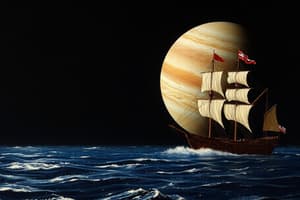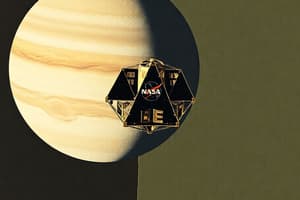Podcast
Questions and Answers
What is the primary goal of NASA's Europa Clipper mission?
What is the primary goal of NASA's Europa Clipper mission?
- To establish a permanent research base on Europa's surface.
- To assess Europa's potential habitability by studying its geology, composition, and interior. (correct)
- To search for definitive evidence of extraterrestrial life on Europa.
- To redirect Europa's orbit to prevent a collision with Jupiter.
According to Dipak Srinavasan, what is the most exciting aspect of Europa?
According to Dipak Srinavasan, what is the most exciting aspect of Europa?
- The presence of unique chemical building blocks.
- The potential existence of water, possibly double the amount found on Earth. (correct)
- Its complex geological features.
- Its proximity to Jupiter.
What are the three key ingredients scientists believe Europa possesses that could potentially support life?
What are the three key ingredients scientists believe Europa possesses that could potentially support life?
- Water, energy, and essential chemical building blocks. (correct)
- A thick atmosphere, sunlight, and a stable orbit.
- Volcanoes, tectonic plates, and a magnetic field.
- Liquid methane, sulfur compounds, and extreme temperatures.
What is the purpose of the remote-sensing instruments aboard the Europa Clipper?
What is the purpose of the remote-sensing instruments aboard the Europa Clipper?
What is a significant challenge to the Europa Clipper mission due to Europa's location?
What is a significant challenge to the Europa Clipper mission due to Europa's location?
Besides the remote-sensing instruments, what other type of instruments are included on the Europa Clipper?
Besides the remote-sensing instruments, what other type of instruments are included on the Europa Clipper?
What is the primary strategy used by the Europa Clipper mission to minimize radiation exposure to the spacecraft?
What is the primary strategy used by the Europa Clipper mission to minimize radiation exposure to the spacecraft?
Consider the challenges of exploring Europa, which of the following hypothetical scenarios would pose the GREATEST risk to the Europa Clipper mission's long-term success, assuming redundancy in critical systems? Assume each scenario occurs independently.
Consider the challenges of exploring Europa, which of the following hypothetical scenarios would pose the GREATEST risk to the Europa Clipper mission's long-term success, assuming redundancy in critical systems? Assume each scenario occurs independently.
Approximately how long does it take the Europa Clipper to reach Jupiter from Earth?
Approximately how long does it take the Europa Clipper to reach Jupiter from Earth?
Europa Clipper is not a life-detection mission, yet it aims to understand Europa's potential habitability. Considering this, which of the following results from the mission would STRONGLY suggest that Europa is NOT habitable, even if liquid water exists?
Europa Clipper is not a life-detection mission, yet it aims to understand Europa's potential habitability. Considering this, which of the following results from the mission would STRONGLY suggest that Europa is NOT habitable, even if liquid water exists?
Besides minimizing time spent in Jupiter's radiation belts, what other method does the Europa Clipper spacecraft use to protect its sensitive electronics?
Besides minimizing time spent in Jupiter's radiation belts, what other method does the Europa Clipper spacecraft use to protect its sensitive electronics?
What is the approximate weight of the Europa Clipper spacecraft?
What is the approximate weight of the Europa Clipper spacecraft?
What intermediate celestial bodies does the Europa Clipper flyby to gain gravity assists on its journey to Jupiter?
What intermediate celestial bodies does the Europa Clipper flyby to gain gravity assists on its journey to Jupiter?
Imagine a future mission aims to land directly on Europa's surface. How might the radiation shielding strategy need to evolve compared to the Europa Clipper mission, and why?
Imagine a future mission aims to land directly on Europa's surface. How might the radiation shielding strategy need to evolve compared to the Europa Clipper mission, and why?
What is implied by the phrase 'Jupiter acts like a giant particle accelerator'?
What is implied by the phrase 'Jupiter acts like a giant particle accelerator'?
The radiation exposure during a flyby of Europa is described as the equivalent of a few million chest X-rays. Assuming that the average chest X-ray delivers a radiation dose of 0.1 mSv, estimate the total radiation dose (in Sieverts, Sv) received by the exterior of the spacecraft during a single flyby. Use scientific notation.
The radiation exposure during a flyby of Europa is described as the equivalent of a few million chest X-rays. Assuming that the average chest X-ray delivers a radiation dose of 0.1 mSv, estimate the total radiation dose (in Sieverts, Sv) received by the exterior of the spacecraft during a single flyby. Use scientific notation.
Flashcards
Europa Clipper
Europa Clipper
NASA's largest spacecraft for a planetary mission, weighing 6.5 tons.
Europa Clipper Solar Arrays
Europa Clipper Solar Arrays
They extend from the 'toes to the crown' if placed at the Statue of Liberty.
Electronics Vault
Electronics Vault
Shielding on Europa Clipper that protects sensitive electronics from radiation.
Jupiter's Role
Jupiter's Role
Signup and view all the flashcards
Radiation Belts
Radiation Belts
Signup and view all the flashcards
Radiation Protection
Radiation Protection
Signup and view all the flashcards
Aluminum Shielding
Aluminum Shielding
Signup and view all the flashcards
Gravity Assist
Gravity Assist
Signup and view all the flashcards
Water on Europa
Water on Europa
Signup and view all the flashcards
Habitability
Habitability
Signup and view all the flashcards
Europa's Radiation Environment
Europa's Radiation Environment
Signup and view all the flashcards
Key Ingredients for Life on Europa
Key Ingredients for Life on Europa
Signup and view all the flashcards
Europa Clipper's 3 Main Exploration Aspects
Europa Clipper's 3 Main Exploration Aspects
Signup and view all the flashcards
Europa Clipper's Main Goal
Europa Clipper's Main Goal
Signup and view all the flashcards
Europa Clipper's Instruments
Europa Clipper's Instruments
Signup and view all the flashcards
Study Notes
- Europa Clipper is NASA's first mission dedicated to studying Jupiter's icy moon Europa.
- Europa is considered one of the most promising places in the solar system to find an environment suitable for life outside Earth.
- Evidence suggests that beneath Europa's frozen surface is a global ocean of water.
- Scientists aim to determine if Europa possesses the right chemistry and energy to sustain life.
- Europa Clipper contains nine instruments plus a gravity experiment.
- It will orbit Jupiter and perform 49 flybys of Europa.
- Data collected will help scientists understand Europa's geology, composition, and interior.
- Europa Clipper will address key questions about Europa's potential habitability.
- The mission is scheduled to launch in October 2024 from NASA's Kennedy Space Center in Florida.
- It is expected to arrive at Jupiter in 2030.
- Europa's most exciting feature is the abundance of water, potentially twice the amount on Earth.
- Exploring Europa is crucial to understanding whether it's a habitable environment that could potentially support life.
- Getting close to Europa is challenging due to the intense radiation environment around Jupiter.
- Europa is about the size of Earth's moon.
- Scientists believe Europa has the three key ingredients to support life: water, energy, and essential chemical building blocks.
- This mission marks the first time a spacecraft is completely dedicated to studying Europa.
- The mission aims to explore Europa's ice and ocean.
- It will study the intersection between the ice and ocean, the chemical composition of the moon, as well as the geology and whether it's active currently.
- The spacecraft will measure light reflected off Europa using remote-sensing instruments like a camera or spectrometer.
- Other instruments will measure the environment around Europa, such as gasses or dust.
- Europa Clipper is the largest spacecraft NASA has ever built for a planetary mission.
- It weighs 13,000 pounds (six and a half tons), about the size of a huge African elephant.
- The solar arrays are massive, extending from the toes to the crown of the Statue of Liberty.
- The solar arrays are technological marvels that must withstand constant radiation exposure.
- Jupiter's radiation environment is intense, with Europa situated in the worst part.
- Jupiter acts like a giant particle accelerator.
- Charged particles trapped in Jupiter's magnetosphere rotate with it and bombard Europa.
- The spacecraft is protected in two ways: minimizing time spent in the radiation environment by orbiting Jupiter and flying by Europa, and housing sensitive electronics in an electronics vault made of about a third of an inch of aluminum.
- With each flyby of Europa, the outside of the spacecraft experiences the equivalent of a few million chest X-rays.
- The trip from Earth to Jupiter will take about 5 ½ years.
- The journey includes a flyby of Mars and another flyby of Earth for gravity assists to slingshot the spacecraft to Jupiter.
- The mission aims to unlock the secrets of Europa.
Studying That Suits You
Use AI to generate personalized quizzes and flashcards to suit your learning preferences.





